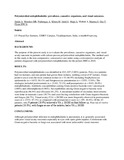| dc.description.abstract | BACKGROUND:
The purpose of the present study is to evaluate the prevalence, causative organisms, and visual acuity outcome in patients with culture-proven polymicrobial endophthalmitis. The method used in this study is the non-comparative, consecutive case series using a retrospective analysis of patients diagnosed with polymicrobial endophthalmitis for the period 2000 to 2010.
RESULTS:
Polymicrobial endophthalmitis was identified in 43/1,107 (3.88%) patients. Forty-two patients had two isolates, and one patient had grown three isolates, yielding a total of 87 isolates. Gram-positive cocci were the most common isolate (n = 53; 60.9%) including Staphylococcus epidermidis (n = 14/53; 16.1%) and Streptococcus pneumoniae (n = 13/53; 13.8%). The etiologies included posttraumatic (n = 31/43; 72.1%) and postoperative (n = 9/43; 20.9%) endophthalmitis. Antibiotic susceptibilities among Gram-positive bacteria were vancomycin (100%) and chloramphenicol (96%). Susceptibilities among Gram-negative bacteria were ciprofloxacin (86.4%) and ofloxacin (81.2%). A maximum number of secondary interventions were done in traumatic cases (38.7%) and cases having coinfection with Gram-negative bacteria and fungus (66.7%). Visual acuity (VA) < 20/200 was more frequently observed in posttraumatic cases (n = 27/31; 87.1%) as compared with postoperative cases (n = 4/9; 44.4%). Of the 43 patients, only 9 patients (20.9%) achieved a VA ≥ 20/200 on final follow-up. Four out of twelve patients (33.3%), with fungus as one of the isolates, had a VA ≥ 20/200.
CONCLUSIONS:
Although polymicrobial infection in endophthalmitis is uncommon, it is generally associated with poor visual acuity outcomes especially in eyes with open-globe injuries. Coinfection with Gram-negative bacteria or fungi was associated with most unfavorable visual outcome. | en |

